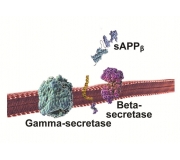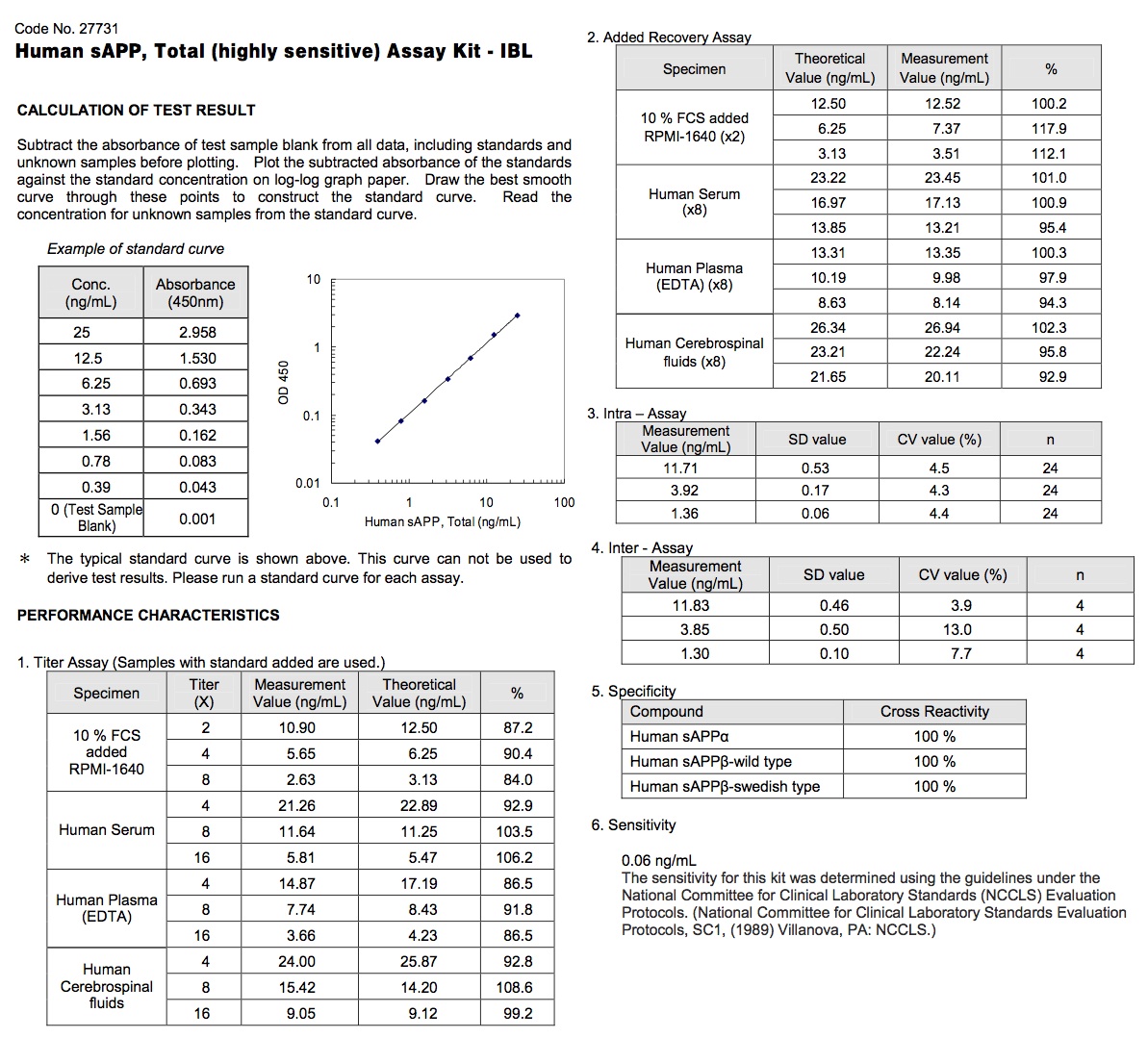sAPP Total (HUMAN SOLUBLE AMYLOID PRECURSOR PROTEIN TOTAL), .06 ng/mL Sensitivity, ELISA KiT (Part 27731 kw. sAPP, amyloid precursor)
 Click to enlarge |
|
Soluble Amyloid Precursor Protein Total, sAPP Total, ELISA Kit (Human Specificity, 96T)
Sensitive and selective colorimetric ELISA kit to total human sAPP with assay range 0.39-25 ng/ml. Highly selective to sAPP. Recognizes both human sAPPalpha and sAPPbeta. The affinity purified monoclonal capture antibody recognizes an epitope situated in aproximately the middle of sAPP and the affinity purified monoclonal-HRP detection antibody detects an epitope at the N-terminus of sAPPalpha and sAPPbeta.
Specifications:
-
Complete 96T ELISA kit in sandwich format. Colorimetric detection at 450 nm.
- ELISA plate is coated with an affinity purified monoclonal antibody that recognizes human sAPP.
-
The kit detects total sAPP in EDTA-plasma, cerebrospinal fluids, serum, and cell culture media.
- EIA buffer contains 1% BSA, 0.05% Tween 20 in PBS
-
Incubation times: Samples with plate; overnight. Detection antibody: 1 hr
-
Assay range: 0.39 - 25 ng/ml. 0.06 ng/ml sensitivity
Background on sAPP
Cleavage of amyloid precursor protein (APP) by “alpha-secretase” creates the extracellular soluble fragment known as sAPPα. Because the “alpha-secretase” cleavage site is within the amyloid-beta molecule, generation of sAPPα by "alpha-secretase" prevents development of fibrillogenic amyloid-beta. The formation of sAPPalpha may therefore be neuroprotective and sAPPalpha may function in neuronal excitability, synaptic plasticity, synaptogenesis, neurite outgrowth, and cell survival. In addition, sAPPalpha appears to modify potassium channels, N-methyl-D-aspartate receptors, and the transcription factor NF kappa B1.
When the beta-secretase cleaves the extracellular domain of amyloid precusor protein (APP) in the first cleavage-processing step towards generating amyloid-beta peptide, the extracellular soluble fragment is known as sAPPbeta. In another cleavage-processing step, gama-secretase embedded in the membrane subsequently cleaves APP within the transmembrane domain and forms the amyloid-beta peptide of variable length.1 This sAPP ELISA detects the presence of total sAPP peptide in cell culture medium and biological fluids, including CSF.
 Methods Overview
Methods Overview-
Equilibrate plate to RT
-
Add sample to plate, incubate overnight
-
Add detection antibody, incubate 1 hr
-
Add color reagents, 30 min
-
Add stop solution. Measure OD at 450nm
sAPP, total ELISA Kit Validation Data

References
-
Selkoe DJ. Normal and abnormal biology of the beta-amyloid precursor protein. Annu Rev Neurosci. 1994;17:489-517.
-
Citron M, Oltersdorf T, Haass C, McConlogue L, Hung AY, Seubert P, Vigo-Pelfrey C, Lieberburg I, Selkoe DJ. Mutation of the beta-amyloid precursor protein in familial Alzheimer's disease increases beta-protein production. Nature. 1992 Dec 17;360(6405):672-4.
-
Hsiao K, Chapman P, Nilsen S, Eckman C, Harigaya Y, Younkin S, Yang F, Cole G. Correlative memory deficits, Abeta elevation, and amyloid plaques in transgenic mice. Science. 1996 Oct 4;274(5284):99-102.
Storage: 4oC, 1 year
Safety: Stop solution contains acid. Avoid contact, wear eye protection.
Shipping: Overnight delivery with styrofoam box and ice packs. International delivery is also available: Please inquire for costs.
kw amyloid precursor protein, amyloid beta, sAPP, ELISA
 Products
Products Manuals
Manuals









